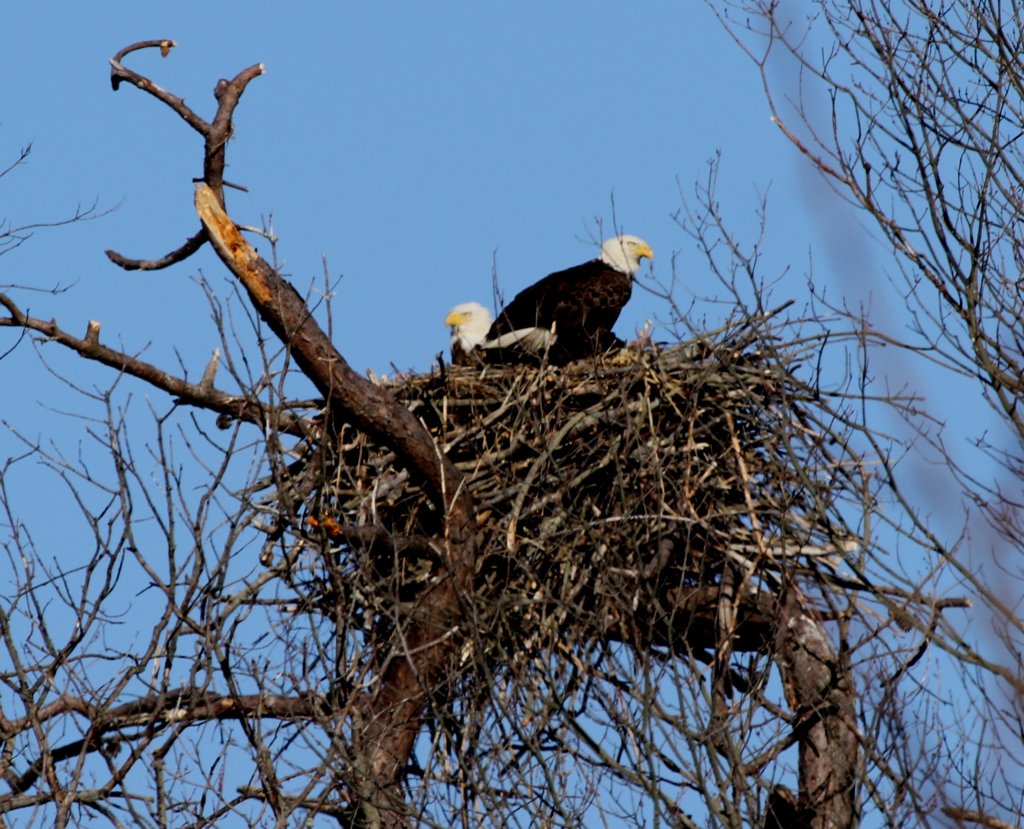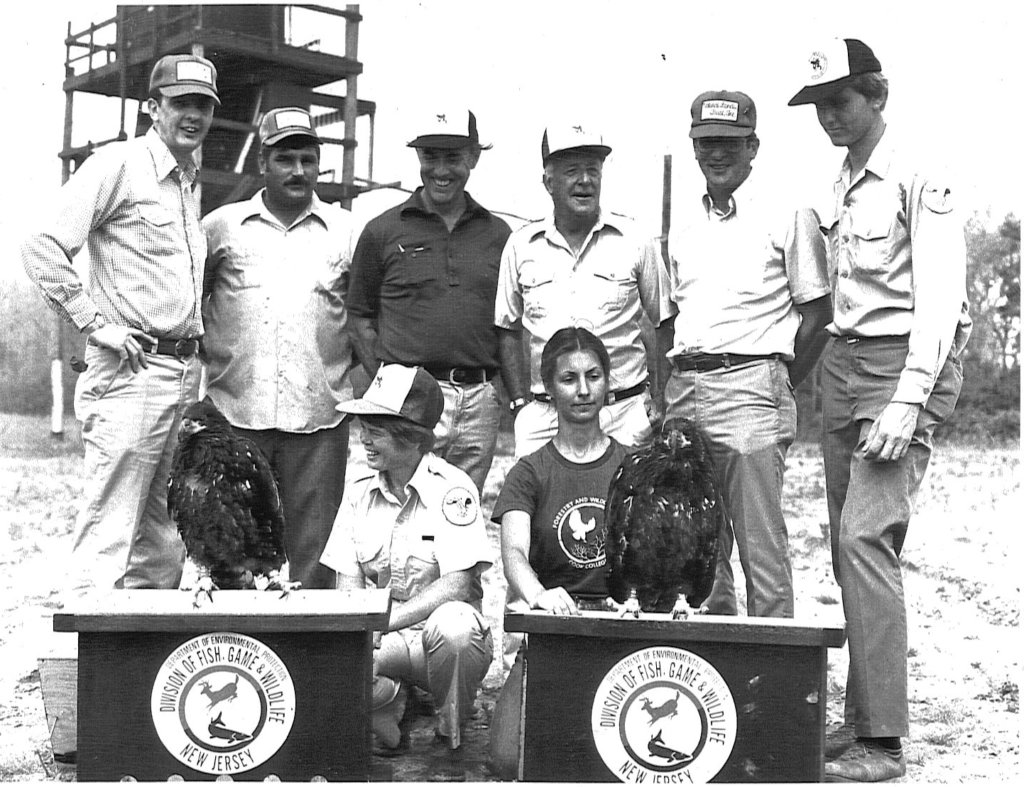Bald Eagles
Sizing them up
One of the largest birds in North America, an adult Bald Eagle can be nearly 38 inches long and have a wingspan of more than 80 inches. A full-grown adult can weigh as much as 14 pounds.
A female Bald Eagle is larger than her male counterpart. Though both sexes will incubate eggs, the female spends more time doing so and her size makes her better suited to shelter both eggs and young from harsh weather. The male’s smaller size reflects his abilities as a fast and nimble hunter.

Eagle nest at Glades Wildlife Refuge, 2013
Speaking of nesting
Bald Eagles construct their nests from sticks, and re-use them year after year. The birds tend to add to their nests annually, so they can become quite large… up to six feet wide and four feet tall! The largest nest ever recorded was more than 9.5 feet in diameter and 20 feet tall.
This species mates for life. However, if one part of the pair dies or becomes sterile, the other bird will seek a new mate.
Bald Eagles typically do not mate until four or five years of age. The female usually lays three eggs from February through April. Both parents incubate the eggs, which hatch after about 35 days.
The hatchlings develop most of their feathers in three to four weeks, hop around the nest at six to seven weeks, and begin to fly at three months. They leave their parents in the fall.
Moral character?
As Americans, we are most familiar with Bald Eagles as a symbol for honor, pride, and majesty. And certainly they are majestic creatures!
But, at the risk of anthropomorphizing, maybe “cunning” would be more appropriate than “honorable.” Bald Eagles will often swoop in to steal a fish from other birds of prey like Ospreys, or feast on carrion, rather than make a kill themselves.
Ben Franklin, in a letter to his daughter opposing the institution of the Bald Eagle as a symbol for a fledgling America, said, “For my own part I wish the Bald Eagle had not been chosen the Representative of our Country. He is a Bird of bad moral Character. He does not get his Living honestly. You may have seen him perched on some dead Tree near the River, where, too lazy to fish for himself, he watches the Labour of the Fishing Hawk; and when that diligent Bird has at length taken a Fish, and is bearing it to his Nest for the Support of his Mate and young Ones, the Bald Eagle pursues him and takes it from him.”
A conservation success
After decades in decline, due largely to habitat loss and a pesticide known as DDT, in 1967 the Bald Eagle was one was of the first species to receive protection under the precursor to the federal Endangered Species Act.
Thanks to conservation efforts, by the 1990s breeding populations of Bald Eagles could be found across most of North America. And, in 2007, the species was removed from the Endangered Species list.
Bald Eagles at our preserves
Many of Natural Lands’ preserves offer ideal hunting and nesting habitat for Bald Eagles. We recently acquired a 1,505-acre property in Chester Springs known as Bryn Coed Farms, which has been home to a nesting pair of eagles for the past several years. And, in south Jersey, our Glades Wildlife Refuge contains one of the largest Bald Eagle roosts in the Delaware Bayshore; birders have spotted as many as two dozen of the majestic birds in one location at one time.
In the early 1980s, Glades was the site of a joint effort to help keep the species from becoming extinct. At the time, only a single nesting pair of Bald Eagles remained in New Jersey. The nest was located deep within a vast, marshy forest within the preserve at the top of a towering pond pine.
Despite the ideal habitat, the eagle pair had not successfully hatched a chick in six years, which scientists believed to be due to residual pesticides in the environment despite the ban on DDT four years earlier. So a daring plan was hatched: in the spring of 1982, staff members replaced the sterile egg the female eagle had laid with a live Bald Eagle chick obtained from a captive pair of eagles in Maryland. And then they waited. About a half-hour after the swap, the adult eagles landed in the nest and accepted the foster eaglet as their own.
The following year, the breeding pair produced two eggs (a surprise to researchers!), which were removed for incubation by the US Fish and Wildlife Service, since the eggshells were about 20 percent thinner than normal and too fragile to survive in the wild. The hatchlings—named “Stars” and “Stripes”—were then returned to the nest to be reared by their parents.
Buoyed by their successes, Natural Lands staff—under the direction of state and federal wildlife experts—constructed a “hacking tower” the following year. The tower consisted of two eight-by-eight-by-six foot cages installed on platforms set 17 and 25-feet high. Small feeding doors and one-way glass panels allowed staff to feed and monitor eagles with minimal human contact. The first residents of the hacking tower were four young eagles donated to the project by the Canadian government. Dubbed “Faith,” “Hope,” “Charity,” and “Courage,” the six-week-old raptors were the first of a total 45 Bald Eagles successfully reared and released from the Glades hacking towers over several years to repopulate New Jersey.

Note the Glades Wildlife Refuge hacking tower in the background.
Thanks to these and other conservation efforts, the state’s Bald Eagle population has rebounded from the brink of extinction. In 2014, researchers counted 142 active nests in New Jersey, which fledged 186 chicks.
“The hacking towers are long gone but fortunately the Bald Eagles aren’t,” said Preserve Manager Brian Johnson. “Every time I see one—which is usually a daily occurrence—it’s a reminder that conservation efforts can make a difference.”
